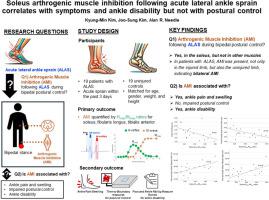当前位置:
X-MOL 学术
›
J. Sport Health Sci.
›
论文详情
Our official English website, www.x-mol.net, welcomes your
feedback! (Note: you will need to create a separate account there.)
Soleus arthrogenic muscle inhibition following acute lateral ankle sprain correlates with symptoms and ankle disability but not with postural control
Journal of Sport and Health Science ( IF 9.7 ) Pub Date : 2024-02-28 , DOI: 10.1016/j.jshs.2024.02.005 Kyung-Min Kim 1 , Joo-Sung Kim 2 , Alan R Needle 3
Journal of Sport and Health Science ( IF 9.7 ) Pub Date : 2024-02-28 , DOI: 10.1016/j.jshs.2024.02.005 Kyung-Min Kim 1 , Joo-Sung Kim 2 , Alan R Needle 3
Affiliation

|
Acute lateral ankle sprains (ALAS) are associated with long-term impairments and instability tied to altered neural excitability. Arthrogenic muscle inhibition (AMI) has been observed in this population; however, relationships with injury-related impairments are unclear, potentially due to the resting, prone position in which AMI is typically measured. Assessing AMI during bipedal stance may provide a better understanding of this relationship. AMI was assessed in 38 young adults (19 ALAS within 72 h of injury: 10 males, 21.4 ± 2.7 years; 19 healthy controls: 10 males, 21.9 ± 2.2 years; mean ± SD) using the Hoffmann reflex (H-reflex) during bipedal stance. Electrical stimulation was administered to identify the maximal H-reflex (H) and maximal motor response (M) from the soleus, fibularis longus, and tibialis anterior muscles. The primary outcome measure was the H/M ratio. Secondary outcomes included acute symptoms (pain and swelling), postural control during bipedal stance, and self-reported function. No significant group-by-limb interactions were observed for any muscle. However, a significant group main effect was observed in the soleus muscle ( = 6.82, = 0.013), indicating significantly lower H/M ratios following ALAS (0.38 ± 0.20) compared to healthy controls (0.53 ± 0.16). Furthermore, lower H/M ratios in the soleus significantly correlated with acute symptoms and self-reported function but not with postural control. This study supports previous evidence of AMI in patients with ALAS, providing insight into neurophysiologic impacts of musculoskeletal injury. Our results suggest that assessing AMI in a standing position following acute injury may provide valuable insight into how AMI develops and guide potential therapeutic options to curb and offset the formation of joint instability.
中文翻译:

急性外侧踝关节扭伤后比目鱼肌关节炎性肌肉抑制与症状和踝关节残疾相关,但与姿势控制无关
急性外侧踝关节扭伤 (ALAS) 与神经兴奋性改变相关的长期损伤和不稳定性有关。在此人群中观察到了关节炎性肌肉抑制(AMI);然而,与损伤相关损伤的关系尚不清楚,可能是由于通常测量 AMI 时采用静息、俯卧位。在双足站立时评估 AMI 可以更好地理解这种关系。使用霍夫曼反射(H 反射)对 38 名年轻人(受伤后 72 小时内 19 例 ALAS:10 名男性,21.4 ± 2.7 岁;19 名健康对照:10 名男性,21.9 ± 2.2 岁;平均值 ± SD)进行了 AMI 评估。双足站立。进行电刺激以识别比目鱼肌、腓骨长肌和胫骨前肌的最大 H 反射 (H) 和最大运动反应 (M)。主要结果指标是 H/M 比率。次要结局包括急性症状(疼痛和肿胀)、双足站立期间的姿势控制以及自我报告的功能。对于任何肌肉都没有观察到显着的逐肢相互作用。然而,在比目鱼肌中观察到显着的组主效应 (= 6.82,= 0.013),表明 ALAS 后的 H/M 比率 (0.38 ± 0.20) 与健康对照 (0.53 ± 0.16) 相比显着降低。此外,比目鱼肌中较低的 H/M 比率与急性症状和自我报告的功能显着相关,但与姿势控制无关。这项研究支持了 ALAS 患者 AMI 的先前证据,提供了对肌肉骨骼损伤的神经生理学影响的见解。 我们的结果表明,在急性损伤后以站立姿势评估 AMI 可能会为了解 AMI 如何发展提供有价值的见解,并指导潜在的治疗选择,以遏制和抵消关节不稳定的形成。
更新日期:2024-02-28
中文翻译:

急性外侧踝关节扭伤后比目鱼肌关节炎性肌肉抑制与症状和踝关节残疾相关,但与姿势控制无关
急性外侧踝关节扭伤 (ALAS) 与神经兴奋性改变相关的长期损伤和不稳定性有关。在此人群中观察到了关节炎性肌肉抑制(AMI);然而,与损伤相关损伤的关系尚不清楚,可能是由于通常测量 AMI 时采用静息、俯卧位。在双足站立时评估 AMI 可以更好地理解这种关系。使用霍夫曼反射(H 反射)对 38 名年轻人(受伤后 72 小时内 19 例 ALAS:10 名男性,21.4 ± 2.7 岁;19 名健康对照:10 名男性,21.9 ± 2.2 岁;平均值 ± SD)进行了 AMI 评估。双足站立。进行电刺激以识别比目鱼肌、腓骨长肌和胫骨前肌的最大 H 反射 (H) 和最大运动反应 (M)。主要结果指标是 H/M 比率。次要结局包括急性症状(疼痛和肿胀)、双足站立期间的姿势控制以及自我报告的功能。对于任何肌肉都没有观察到显着的逐肢相互作用。然而,在比目鱼肌中观察到显着的组主效应 (= 6.82,= 0.013),表明 ALAS 后的 H/M 比率 (0.38 ± 0.20) 与健康对照 (0.53 ± 0.16) 相比显着降低。此外,比目鱼肌中较低的 H/M 比率与急性症状和自我报告的功能显着相关,但与姿势控制无关。这项研究支持了 ALAS 患者 AMI 的先前证据,提供了对肌肉骨骼损伤的神经生理学影响的见解。 我们的结果表明,在急性损伤后以站立姿势评估 AMI 可能会为了解 AMI 如何发展提供有价值的见解,并指导潜在的治疗选择,以遏制和抵消关节不稳定的形成。
















































 京公网安备 11010802027423号
京公网安备 11010802027423号